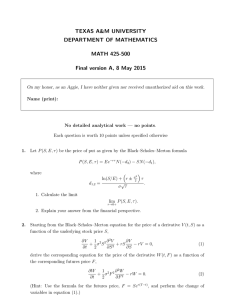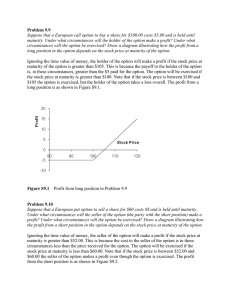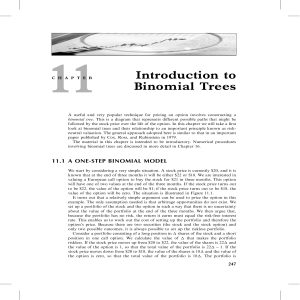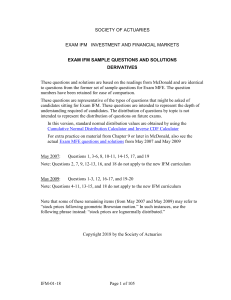Answer ONE question from SECTION A and ONE question from
advertisement
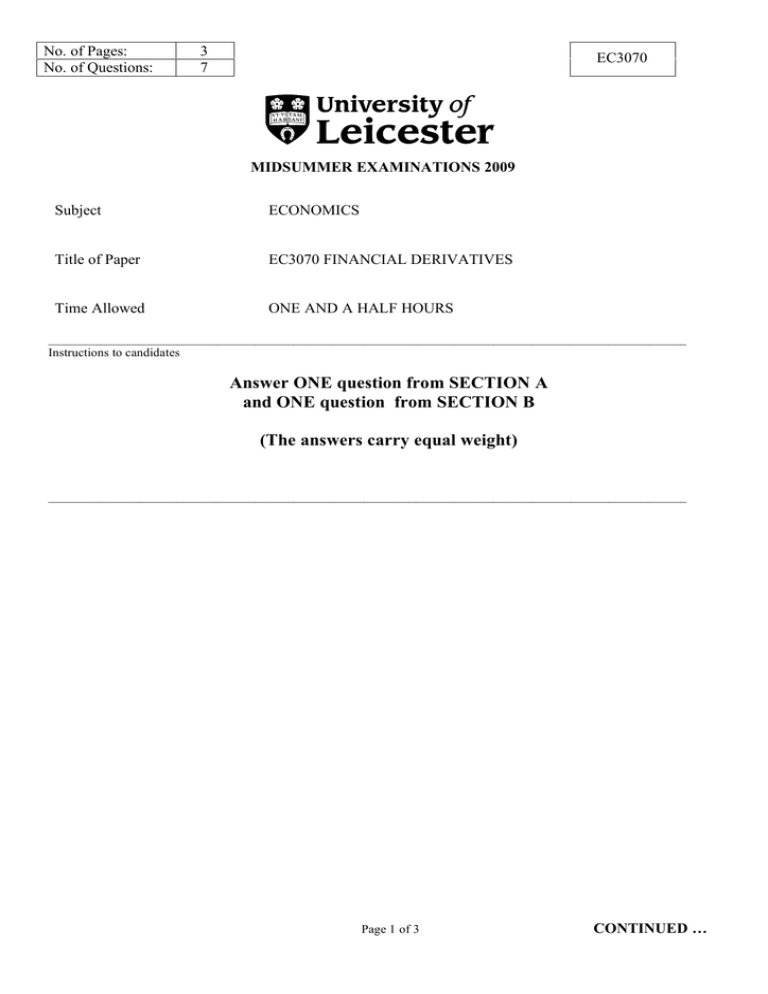
No. of Pages: No. of Questions: 3 7 EC3070 MIDSUMMER EXAMINATIONS 2009 Subject ECONOMICS Title of Paper EC3070 FINANCIAL DERIVATIVES Time Allowed ONE AND A HALF HOURS ___________________________________________________________________________________________________ Instructions to candidates Answer ONE question from SECTION A and ONE question from SECTION B (The answers carry equal weight) ___________________________________________________________________________________________________ Page 1 of 3 CONTINUED … EC3070 Section A 1. Consider a long position in a European call option with a strike price K1 . (a) Graph the profit from this investment as a function of the spot price at maturity, and explain the graph. (b) Carefully explain the consequences on the initial investment and the profit profile of adding to this portfolio a short position in a call option with the same underlying asset, maturity date and with strike price K2 with (i) K2 < K1 and (ii) K2 > K1 . (c) Explain the differences between a strip, a strap and a straddle. Under which circumstances would you recommend each of them as a trading strategy? 2. Establish the formula for the present value of a stream of n annual payments of £a, which begin in one year’s time, when the risk-free rate of interest r is used in forming the discount factor. For an investment of £1,000, option A offers you annual payments of £50 in perpetuity. Option B offers you ten annual installments of £45 and the return of the £1,000 together with the final installment. Evaluate these two options and declare which of them you would prefer, if you do not regard them as equal. (Hint. you may assume that there is a risk-free annual rate of interest of 5%.) 3. A stock price is currently S0 = 50. At the end of the month, it will be either S1u = 60 or S1d = 40. The risk-free rate of continuously compounded interest is 6% per annum. What is the value c1|0 of a one-month European call option with a strike price of $45? Give a detailed explanation of your reasoning. CONTINUED Page 2 of 3 EC3070 Section B 4. Describe and explain the financial circumstances affecting any two of the following events: (a) The run on Northern Rock and the demise of Lehman Brothers, (b) The crash of the Wall Street stock market in 1929, (c) The bail-out of Long Term Capital Management in 1998, (d) The collapse of the AIG insurance empire, (e) The acquisition, by trading in financial markets, of a controlling interest in the Volkswagen company by the Porsche company. 5. Describe the provisions for the financial protection of farmers and traders in agricultural commodities that are offered by the Chicago Board of Trade. Are the activities of the Board of Trade in protecting the interests of these parties helped or hindered by the presence of market speculators? 6. Give the mathematical definitions of the following stochastic processes: (a) A standardised Wiener process, (b) Arithmetic Brownian motion, (c) Geometric Brownian motion. Let the equation describing the evolution of the spot price S of a financial asset be dS = Sµdt + Sσdw(t), where dw(t) denotes a standardised Wiener process. With reference to Ito’s lemma, derive the expression for the logarithm of the process. What effect does the level of volatility have upon the rate of drift? What features of our experience of the real world are missing from the equation? 7. Derive the one-step binomial formula for the premium of a European call option written at time t = 0 and with a date of expiry at time t = τ . Generalise the formula to the case of an n-step binomial model and indicate how this converges on the Black–Scholes option pricing formula as n → ∞. Give an account of the properties of the Black–Scholes formula in terms of the ceteribus paribus variations of its several arguments and comment on the realism of the assumptions that underlie the model from which it is derived. END OF PAPER Page 3 of 3
